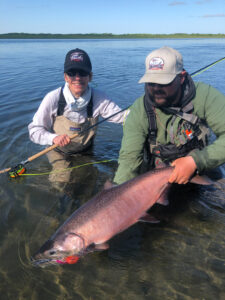Fly Fishing for King Salmon
The largest of the Pacific Salmon, Chinook—commonly referred to as King salmon—is Alaska’s state fish, and an important sport and commercial fish. Typical King salmon weigh in between 10 and 50 pounds. Alaskans devote many hours to the pursuit of Chinook salmon and with good reason. A king gives an incredible fight! It is a thrilling experience that leaves you understanding why they are called “Kings.”
Because of their sheer strength and endurance—it is not uncommon for a fight with a king to last you 30 minutes. They are available from mid-June to the end of July. While they can be fished in both fresh water and salt water, the best fishing occurs in the fresh waters where they spawn. The Nushagak is home to one of the most massive runs in Alaska, averaging about 80,000 Chinook annually. Large runs also occur in the Alagnak drainage and down the Alaska Peninsula.
If you’re feeling adventurous and would like to learn more about fly fishing for Chinook salmon, contact No See Um Lodge to learn how we can help plan your next great fishing experience!
King Salmon Fishing Flies
The King Salmon diet consists primarily of plankton, insects and fish. Large, weighted flies are recommended, in sizes #2 to #5. Marabou, shrimp, squid, and rabbit strip flies are popular and are most effective in black, red, purple, orange, and pink colors, as well as blue and chartreuse. Alaska Fly Fishing Goods recommends mid- to large-profile flies, often tied in two contrasting colors…some favorites include Stinger Prawns, Guide Intruders, Fat Freddies, and Articulated Hareball Leeches.
King Salmon Fly Fishing Tips
One of the most important things to keep in mind about King salmon is that they are some of the heaviest and fiercest fighting sport fish in Alaska. They are much larger on average than other fish you might be familiar with, so 9 wt spey rod or 10wt single hand are ideal. Fast sinking lines are also highly recommended. Remember, Chinook salmon don’t like the light; they hide from it. This means that you should be equipped with a fishing line that can fish in deeper waters. Most Kings hide from the light between four and twelve feet below the surface of the water.
Fly fishing for king Salmon is one of the most exhilarating experiences Alaska fishing has to offer—don’t wait, contact No See Um Lodge today!
Chinook Salmon Life History
Chinook salmon, like all species of Pacific salmon, hatch in freshwater but migrate to sea to mature and feed. This makes them anadromous. While in the ocean, Chinook salmon have a vivid bluish-green color on their backs, which gradually fades from silver on their sides to white on their belly. Adult Chinook have irregular black spots on their back, dorsal and tail fins, and a blackish gum line that sometimes earns them the name “blackmouth.” Juvenile Chinook salmon, known as fry, in fresh waters have parr marks bisected by the lateral line. They are called smolt once they head to the ocean to mature, and at this stage they have silver sides and parr marks that recede to above the lateral line.
Chinook return to spawn in fresh waters, where their color ranges from red to copper in males, to dark gray in females, depending on their location. These fish can live from three to seven years, and after about four years, adult males develop defined ridges along their backs and a hooked nose or upper jaw. Females have a more torpedo-shaped body with blunt noses and a robust mid-section.
According to the Alaska Department of Fish and Game, the anadromous Chinook salmon hatches “in fresh water and rear in main-channel river areas for one year. The following spring, Chinook salmon turn into smolt and migrate to the salt water estuary. They then spend anywhere from 1-5 years feeding in the ocean and return to spawn in fresh water. All Chinook salmon die after spawning.” King salmon in their spawning stage run the gamut of sizes, because they naturally reach maturity at different phases in their lives. A three-year-old may have reached maturity, but can only weigh four pounds because they are still young, whereas a Chinook that does not mature until age seven can weigh upwards of fifty pounds at maturity. Females tend to be older when they mature than males.
Developing Chinook eggs, fry, juveniles, and even spawning Chinook all thrive in fresh water streams estuaries before migrating to the salt water estuaries. In Alaska, according to the Department of Fish and Game, Chinook salmon can be found from the southeastern panhandle to the Yukon River. Primary spawning waters include the Yukon, Kuskokwim, Nushagak, Kenai, and Alagnak rivers, though many populations can also be found in smaller streams.

Spey fishing in Alaska | No See Um Lodge · January 3, 2018 at 9:09 am
[…] reinforcement. During the week of 18th-25th we will shift our attention towards swinging for kings. There’s not much that can compare to hooking a 20+ pound king with a spey […]